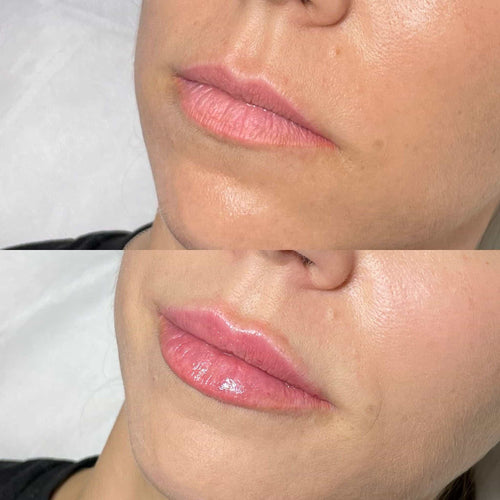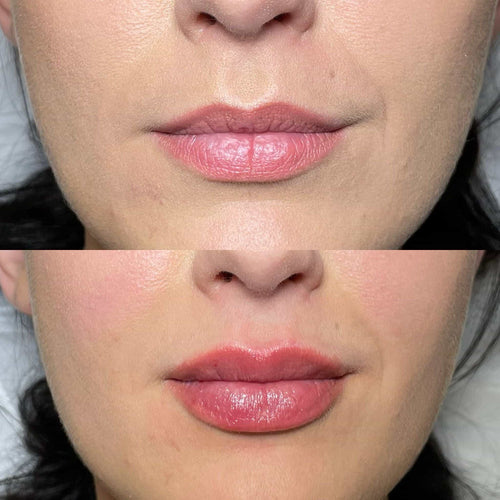Book a Consultation for Dermal Fillers with Dr. Laura Geige Today
Recovery Timeline
Initial Days
Recovery from facial fillers typically involves a short downtime period, and while you may be eager to get back to your usual routine, it’s important to follow your injector’s post-treatment instructions carefully.
During the **initial days** after filler injections, avoid sleeping on your face for at least **24-48 hours**. This allows the injected product to settle into its place and minimizes the risk of **bruising**, **swelling**, or the filler migrating from its intended location.
During this period, it’s best to sleep on your back or side. Use extra pillows to support your head and neck in a comfortable position that keeps pressure off your treated areas.
Your injector may recommend using an ice pack for 10-15 minutes at a time several times a day to reduce swelling. Applying a cold compress can also help minimize bruising.
Avoid strenuous activities, including exercise, that could increase blood flow and potentially cause more swelling or bruising. You should also refrain from touching or massaging the treated area to prevent further irritation.
Remember that everyone’s healing process is different, so your injector will provide personalized advice based on the type of filler used, the amount injected, and your individual circumstances.
The First Week
Recovery from dermal filler injections typically involves a period of downtime during which certain activities should be avoided to minimize swelling, bruising, and potential complications.
During the **first week** following facial filler treatment, it’s generally recommended to avoid sleeping on your face.
Here’s why:
* Swelling and bruising are common side effects of dermal fillers. Sleeping on your face can increase pressure on the injected areas, exacerbating these effects.
* **Disruption** of filler placement is possible if you sleep on your face, potentially leading to asymmetry or unevenness.
Instead, it’s best to sleep on your back or side for the first week. This allows the fillers to settle properly and minimizes pressure on the injection sites.
Remember to follow your provider’s specific instructions regarding recovery and any restrictions they may have.
They will be able to provide tailored advice based on the type of fillers used, the areas treated, and your individual healing process.
It is crucial to prioritize your recovery to ensure optimal results and minimize any potential risks.
Gradual Return to Normal
Recovery timelines for facial filler treatments vary depending on several factors, including the type and amount of filler used, the individual’s healing process, and adherence to post-treatment instructions. Generally, it’s recommended to avoid sleeping face down for at least a week to prevent pressure on the treated areas and potential migration or distortion of the filler.
During the initial days after treatment, swelling and bruising are common side effects. Sleeping with your head elevated can help minimize these symptoms. It is also important to avoid touching, rubbing, or massaging the treated areas.
As you progress through the recovery period, you may gradually feel less swelling and discomfort. You can start experimenting with sleeping on your side after a few days, but continue to avoid face-down positioning until your injector clears you for it, typically around one week post-treatment.
Remember, individual healing rates differ. It’s crucial to follow your injector’s specific instructions and consult them if you have any concerns or experience unexpected complications.
Your injector can best assess your individual case and advise on the appropriate time frame for resuming your normal sleeping positions.
Sleeping Positions During Healing
Importance of Elevation
Sleeping position plays a crucial role in the healing process after receiving dermal fillers, particularly facial fillers. Certain positions can minimize swelling, bruising, and the risk of uneven or distorted results.
Ideally, avoid sleeping on your face or stomach for at least the first few days following treatment. These positions can put pressure on the treated areas, potentially causing filler displacement or migration.
Sleeping on your back is generally recommended as it minimizes pressure and promotes even healing. You can use an additional pillow to slightly elevate your head, which further reduces swelling by improving lymphatic drainage.
The importance of elevation in the context of facial filler healing cannot be overstated. Elevation helps to reduce fluid buildup in the face, minimizing puffiness and promoting a smoother recovery. Think of it as helping gravity work in your favor.
Elevating your head by 30 degrees or so using an extra pillow can significantly impact your results. This simple adjustment encourages lymphatic drainage, allowing excess fluids to move away from the treated areas more effectively.
Pillow Choices
Choosing the right sleeping position and pillow after facial filler injections is crucial for optimal healing and minimizing swelling, bruising, and distortion.
For the first **24-72 hours** following your treatment, it’s generally recommended to avoid **sleeping on your face or stomach**. These positions put pressure on the treated areas, increasing the risk of lumpiness, migration of filler, or even bruising.
Instead, opt for **sleeping on your back** with an extra-supportive pillow.
Here are some pillow choices to consider:
* **Memory foam pillows:** These contour to your head and neck, providing good support and reducing pressure points.
* **Buckwheat pillows:** These offer adjustable loft and breathability, allowing you to customize the height and firmness for your comfort.
* **Inflatable pillows:** You can adjust the height and firmness of these pillows, ensuring proper support without excessive pressure on your face.
Avoid **thin or flat pillows**, as they don’t provide enough support and can lead to discomfort and potentially compromise healing.
Throughout the **entire healing process**, it’s important to maintain a gentle touch around the treated area. Avoid rubbing, touching excessively, or sleeping with your face pressed into a pillow.
Be sure to consult with your provider for specific instructions regarding sleeping position and pillow choice after your facial filler treatment. They can provide personalized recommendations based on the type of filler used and your individual needs.
Alternative Sleeping Arrangements
The best sleeping position after getting fillers depends heavily on the specific type of filler used and the area treated. Generally, avoiding pressure on the injected areas is key during the initial healing period.

For most facial fillers, sleeping on your back or side with your head elevated is recommended for the first few days to a week. This helps minimize swelling and bruising and allows the filler to settle properly.
Sleeping on your stomach, particularly with your face pressed into the pillow, should be avoided as it can distort the results, cause discomfort, and potentially lead to filler migration or lumping.
Alternative sleeping arrangements during this time might include:
• **Using an extra pillow:** Place a pillow under your knees when sleeping on your back to further elevate your head and reduce pressure on your face.
• **Experiment with different pillow shapes:** Memory foam or contoured pillows can offer more support and minimize facial contact.
• **Sleep with your head propped up:** Consider a wedge pillow or elevating the head of your bed for added comfort and to discourage face-down sleeping.
It’s crucial to follow your injector’s specific post-treatment instructions as they may recommend alternative sleeping arrangements based on the type of filler used, the areas treated, and your individual healing needs.
Remember, prioritizing proper sleep positioning during the initial recovery period is essential for achieving optimal results and minimizing potential complications.
Long-Term Considerations
Potential Complications
Sleeping position following filler injections is a crucial factor in ensuring optimal results and minimizing complications.
While generally safe, facial fillers are injected into delicate tissues, and pressure from sleeping on your face can lead to uneven distribution, bruising, or displacement of the filler.
Typically, dermatologists recommend avoiding sleeping on your face for at least a few days, sometimes up to a week, following filler injections.
During this initial recovery period, it’s important to sleep on your back or side to minimize pressure on the treated areas.
Using additional pillows can help elevate your head and maintain proper positioning.
Long-term considerations regarding sleeping position after fillers are less about strict restrictions and more about maintaining facial symmetry and longevity of results.
While you don’t necessarily have to sleep on your back forever, it might be wise to avoid consistent sleeping on your face long term as it could gradually lead to asymmetry or filler migration.
Potential complications associated with sleeping on your face after fillers include:
Book a Dermal Filler Consultation with Dr. Laura Geige Now
• **Asymmetry:** Pressure can cause one side of the filler to shift or spread unevenly, resulting in an asymmetrical appearance.
• **Bruising and Swelling:** Increased pressure on blood vessels can lead to bruising and swelling around the injection sites.
• **Filler Migration:** The filler material may move from its intended location due to pressure, potentially changing the desired outcome or creating lumps.
• **Loss of Volume:** Repeated pressure can gradually compress the filler, leading to a less defined and plump appearance over time.
Consultation with a Provider
Long-term considerations regarding sleeping position post-filler injection are crucial for optimal results and minimizing potential complications.
While most filler types settle within a few days, sleeping on your face too soon can disrupt the newly injected gel, leading to unevenness, distortion, or migration. It’s essential to prioritize healing and allow the filler to integrate naturally into the skin.
Reserve Your Dermal Filler Appointment with Dr. Laura Geige Now
Here are some long-term considerations:
- Follow your provider’s specific instructions carefully regarding sleeping positions post-procedure. They will provide personalized advice based on the type of filler used, the treated area, and your individual healing needs.
- Avoid sleeping on your face for at least a few days to a week after your injection. This allows the filler time to set and minimizes the risk of displacement or bruising.
- Sleeping with your head elevated can help reduce swelling and promote proper drainage, contributing to faster healing.

Consultation with a provider is essential for personalized advice and guidance.
Here’s why you should consult with your provider:
- They understand the specific filler used, its properties, and how it behaves within the skin.
- They can assess your individual healing process, taking into account factors like skin type, age, and health conditions.
- They can address any concerns you may have about sleeping position, potential side effects, and long-term results.
Individualized Guidance
Long-term considerations play a crucial role when deciding when it’s safe to sleep on your face after getting dermal fillers.
Fillers, though generally safe, require time to settle and integrate into the surrounding tissues. Sleeping on your face can disrupt this process, potentially leading to uneven results, lumpiness, or migration of the filler.
Individualized guidance from a qualified injector is essential for determining the appropriate recovery timeline.
Factors influencing this timeframe include:
– Type of filler used: Some fillers are designed to be more stable than others.
– Amount of filler injected: Larger volumes may require a longer settling period.
– Location of injection: Areas that receive more pressure during sleep, like the cheeks or lips, might need additional recovery time.
– Your individual healing process:
Factors such as age, health, and lifestyle can influence how quickly your body heals.
Your injector will assess these factors during your consultation to provide personalized recommendations.
Generally, it’s recommended to avoid sleeping on the treated area for at least a few days to a week after filler injections.
During this period, focus on supporting your head and neck with pillows that prevent pressure on the injected areas.
Communicate openly with your injector if you experience any discomfort or notice any changes in the appearance of the treated area.
Adhering to their instructions will help ensure optimal results and minimize potential complications.
James Martin Live Lace and Scotch K’s P Rules Cakes Lottie London Aesthetics
- Sitting Scissors Sex Position - January 2, 2025
- The Top Designer Lingerie Brands You Need To Know - December 18, 2024
- When Can I Sleep On My Face After Fillers? - December 17, 2024
